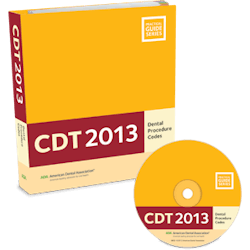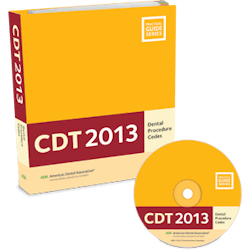4 Coding Tips to Stop Leaving Money on the Table
by Jim Philhower
---------------------------------------------------
Additional articles by Jim Philhower
- 4 Ways to Increase Your Production by $100,000
- How PPOs are Affecting the Value of Your Practice
- Recapture the Joy of Practicing Dentistry
---------------------------------------------------
As the dental benefits landscape continues to shift to PPOs and reimbursement rates continue to shrink, many offices are struggling with increasing overhead and decreasing cash flow and profit margins. Coding correctly is critical for maximizing reimbursement, increasing cash flow, and minimizing any coding errors that could result in fines or worse.
The following are four codes to help you get started in 2014.
1. Fluoride Codes D1208 and D1206
Fluoride codes D1203 and D1204 for child and adult fluoride treatments were discontinued in 2013. They were replaced with code D1208, which is used for child and adult applications. We still see many offices reporting the old codes and most likely not being reimbursed for the procedures.
There were also changes to the fluoride varnish code D1206 last year. Previous restrictions to patients with moderate to high caries risk have been eliminated. D1206 is applicable for child and adult reporting and pays a higher UCR than D1208.
2. D0140 Limited Oral Evaluation – Problem Focused or D9110 Palliative (Emergency) Treatment of Dental Pain
D9110 is an underutilized code; overwhelmingly offices code D0140 for emergency visits when treating a patient for pain or discomfort. D0140 is an evaluation code and limited to the "one evaluation per six months" or "two evaluations per year" rule. Consider reporting D9110 for minor nondefinitive procedures to reduce discomfort, sensitivity, or pain at an emergency visit. D9110 is a procedure code and will not use one of the exam limitations. This palliative code pays a higher UCR than D0140. When reporting D9110, include the required narrative. Palliative D9110 should not be used in conjunction with a definitive procedure.
3. D0180 Comprehensive Periodontal Evaluation – New or Established Patient
This evaluation code may be reported for established periodontal patients, patients showing signs or symptoms of periodontal disease, and for patients with risk factors such as smoking and diabetes. D0180 requires a complete and detailed periodontal evaluation, including full-mouth probing and detailed charting. D0180 may be reported at the same visit as a D4910; however, it may be downgraded to a D0120 fee. Do not report D0180 in addition to a D0150 comprehensive evaluation. D0180 usually pays a slightly higher UCR than D0150.
4. D1352 Preventative Resin Restoration in a Moderate to High Caries Risk Patient – Permanent Tooth
D1352 is a conservative restoration of an active cavitated lesion in a pit or fissure that does not extend into dentin, and includes placement of a sealant in any radiating noncarious fissures or pits. Do not report this preventive type resin restoration if the prep and decay extend into dentin. See D2391 for one-surface composite. Do not report this preventative restoration if there is no active decay in the enamel. See D1351 for sealant. Do not report D1352 for a primary tooth. According to Dr. Charles Blair, some plans will pay more than two times the fee for a sealant but less than a one-surface composite, and some plans will pay the alternate sealant benefit.
The average dental office can increase production tens of thousands of dollars a year simply by using these and other codes properly. We recommend combining a Henry Schein Practice analysis along with Dr. Charles Blair's Practice Booster to maximize coding efficiencies, cash flow, and reduce costly errors.
For help with coding, visit www.HenryScheinBusinessSolutions.com and request a practice analysis.
Jim Philhower, a 28-year veteran of the dental industry, is the director of North America Dental Sales Leadership and Development for Henry Schein Dental. Jim teaches dental teams throughout the world techniques to help reach their practice goals. Contact him at (800) 372-4346 or send an email to [email protected]. Learn more at www.HenryScheinBusinessSolutions.com.

